The Dirty Truth: Why You Shouldn’t Shower When its Raining and what Opti’s Cloud-based IoT platform is Doing to Help

The digital transformation has created opportunities for businesses to address such capacity problems in ways never previously imagined, OptiRTC provides solutions at the for reducing the stress on the stormwater management system by providing accurate information on the levels of water in various tanks, reservoirs and holding ponds so that governments can control how much water is getting discharged from CSOs and keeping our waterways clean.
If you ask the City of New York Environmental Protection Agency what the best way is to help keep local waterways clean, they will tell you to limit your water usage by not showering or washing dishes during a rain storm to prevent raw sewage from being discharged into local rivers [1]. In cities with aging infrastructure, extended period of rain can overwhelm a Waste Water Treatment Plant (WWTP) which can cause any excess water being put into the system to be directly discharged through a Combined Sewage Overflow (CSO). For older cities this is of increasing concern for sanitation issues and keeping waterways clean for public use.
Exhibit 1
The digital transformation has created opportunities for businesses to address such capacity problems in ways never previously imagined. After Super Storm Sandy hit New York City, the idea that older U.S. cities are not very resilient to extreme weather events became a topic of discussion. OptiRTC is an Internet-of-Things (IoT) company with an operating model which has networked multiple water-level meters to enable governments to put in place an appropriate stormwater storage infrastructure. Additionally they are able to increase response to “overflow events” through a cloud-based platform for active and centralized control [2]. For businesses and governments concerned about large storms or extreme weather events overwhelming a city’s infrastructure, OptiRTC provides solutions at the for reducing the stress on the stormwater management system by providing accurate information on the levels of water in various tanks, reservoirs and holding ponds so that governments can control how much water is getting discharged from CSOs [3].
For cities in the future, infrastructures must be able to adapt and react to a changing climate. IoT when used for this purpose is a network of physical stormwater storage mechanisms embedded with electronics which allow the water levels to be sensed and controlled remotely across network infrastructure [4]. Through sensors that feed data on weather conditions, water storage levels and sewage levels, OptiRTC’s operating model is to create a digital ecosystem that combines this information and controls pumps to know when to hold water and when to release it back into the system. With aging infrastructure in cities combined with increased population density and increasing extreme weather events, OptiRTC has an opportunity to grow even further in this field.
Exhibit 2
Similarly, the Business model for OptiRTC would not exist without this level of technology and the ability to have a connected system to remotely control stormwater tanks and be able to prevent overflows in a city. As the first movers in the stormwater management industry they are both creating the market by showing cities that flooding and using CSO’s does not have to be a reality, as well as being the only ones currently providing this service [5]. As they are unique to this space and are building a market while selling their service, they must clearly define their target consumer. Currently OptiRTC offers products to aid cities and municipal governments, as well as products for private businesses with EPA runoff concerns. These two sets of customers provide very different value propositions that show the range of services that can be provided, but can capitalize off the improvements of the other type of customer.
Going forward Opti should consider going into Public-Private partnerships which can combine their disparate customers and create even greater network effects. This can benefit businesses as well as the cities where they are located by being able to use private land to help city infrastructure for water storage as well as to improve water quality by allowing collected stormwater to go through WWTPs after the peak demand and avoid getting discharged into a CSO.
As you can see from the pictures above taken during the storm this week of our local CSO on the Charles River, this is an issue that we should be concerned with as well. Cambridge Massachusetts Department of Public Works warn that CSO’s in the city act as a “relief valve” so that water does not back up into homes and businesses or onto the streets, and has published public health warnings to avoid coming into contact with the Charles River or Alwife Brook for at least 48 hours after a rainstorm due to contamination[6]. This is not a remote issue that OptiRTC is addressing, but an infrastructure problem that affects millions of people that can be solved with IoT cloud-based technology that can keep city stormwater systems from overflowing and contaminating public use waterways.
(744 words)
Footnote:
[1] New York City Environmental Protection, “Wait…Pilot Program,” http://www.nyc.gov/html/dep/html/stormwater/wait_program.shtml, accessed November 17, 2016.
[2] Mary Catherine O’Connor, “How Opti Leverages the IoT to Improve Stormwater management,” Internet of Things Journal, http://www.iotjournal.com/articles/view?14863/, accessed November 12, 2016.
[3] OptiRTC, “Use Opti to Control Stormwater,” https://optirtc.com/products/nimbus/ , accessed November 17, 2016.
[4] Jamie Lefkowitz, Alexa Sarmanian, Marcus Quigley, “Continuous Monitoring and Adaptive Control – the Internet of Things Transforms Stormwater Management,” Journal of the New England Water Environmental Association. Vol 50:1, Spring 2016. http://www.newea.org/wp-content/uploads/2014/03/NEWEA-Journal_Spr16.pdf#page=25 , accessed November 12, 2016.
[5] Steve Boulanger, interview by author, Cambridge, Massachusetts, November 17, 2016.
[6] Cambridge Department of Public Works, “Combined Sewer Overflows,” https://www.cambridgema.gov/theworks/ourservices/stormwatermanagement/combinedseweroverflows1 , accessed November 12, 2017.
Exhibits
[1] Cambridge Department of Public Works, “Combined Sewer Overflows,” https://www.cambridgema.gov/theworks/ourservices/stormwatermanagement/combinedseweroverflows1 , accessed November 12, 2017.
[2] Jamie Lefkowitz, Alexa Sarmanian, Marcus Quigley, “Continuous Monitoring and Adaptive Control – the Internet of Things Transforms Stormwater Management,” Journal of the New England Water Environmental Association. Vol 50:1, Spring 2016. http://www.newea.org/wp-content/uploads/2014/03/NEWEA-Journal_Spr16.pdf#page=25 , accessed November 12, 2016.
[3] Photo by author, taken November 15, 2016.


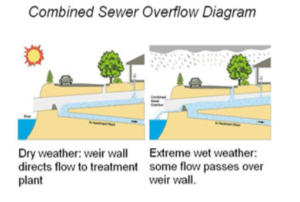

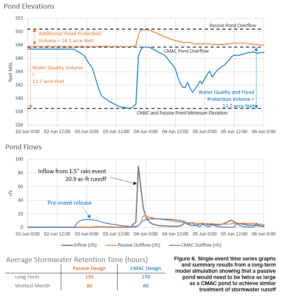
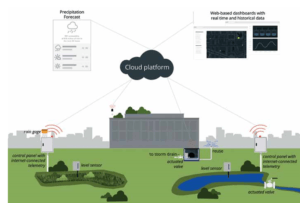
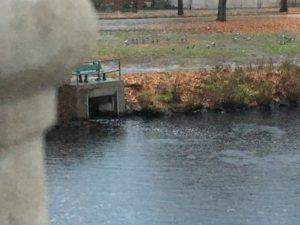
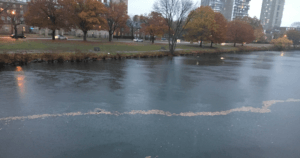
F, really enjoyed your post. It hits home how this issue is affecting our Cambridge and Boston communities. I was not aware of the impact of showering during rainstorms but it makes sense that every little bit helps. I hope that more cities and companies adopt this technology.
Very interesting article. I’m curious about your suggestion for Public-Private partnerships in the future. Are businesses incentivized enough to take on such roles, or contribute private land? As with many climate-related challenges, I wonder whether we are facing a Tragedy of the Commons type dilemma. Whose responsibility is it, when no one is truly held accountable? Similarly, how incentivized are individuals to change behavior, such as not showering during rainstorms, when there is no direct correlation or consequence?